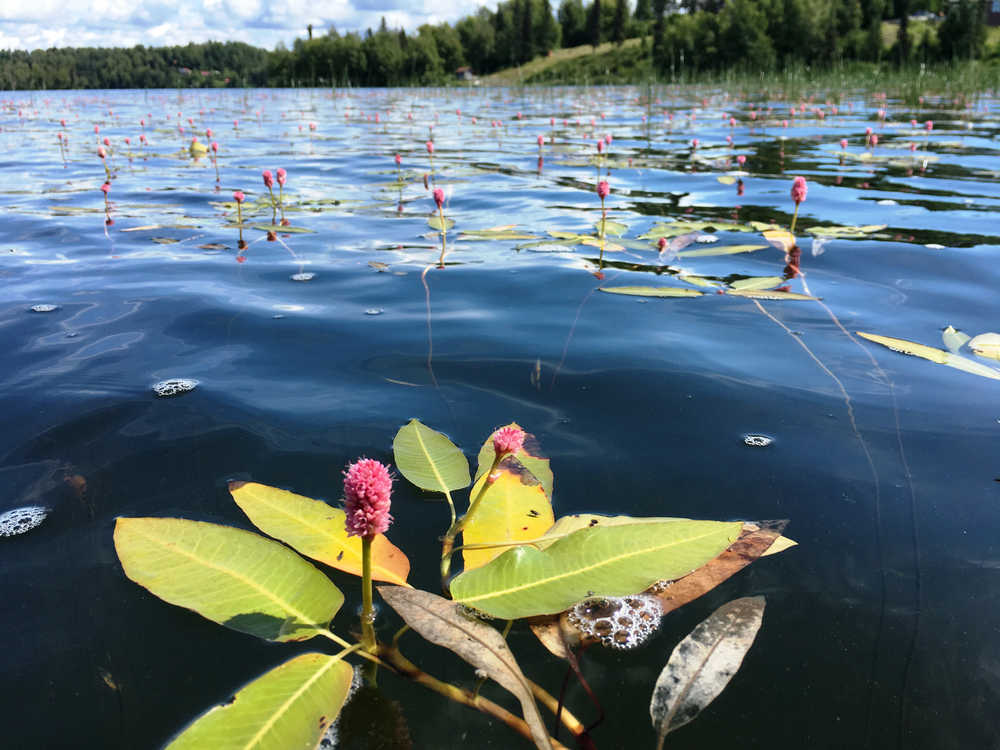It was a beautiful sunny day and we were well into surveying for the hybrid Elodea on Daniels Lake. The sun was beating down on us and I suddenly realized that it is indeed possible to get sunburn in Alaska. Elodea is an invasive waterweed and we were hoping that previous efforts to eradicate it were successful and that we would not be detecting any on our sampling rakes. After pulling up an array of native aquatic plants but no Elodea most of the day, we were confident that it wouldn’t be showing up anytime soon.
Being a Florida native, Alaska sunburns aren’t the only thing I’m not used to. There are many plants that I’m not used to seeing here on the peninsula. One of these plants is the water smartweed (Polygonum amphibium) which caught my eye as our boat rounded a corner. It’s pretty recognizable with its bright pink buds that shoot up on a stalk a few inches from the water’s surface. There were so many that this area of the lake appeared dotted with pink.
But this plant is more than just a pretty sight—it’s incredibly interesting and serves many different functions. Not only is it native to Alaska, but this plant is found almost everywhere across the U.S. except for my home state of Florida, Georgia, Alabama and, not surprisingly, Hawaii. It’s also native to Asia, Europe, and parts of Africa.
As you can tell from its extensive range, Polygonum is a large and variable genus of around 65-250 species, depending on how taxonomists classify it. Common names for this genus include knotweed, knotgrass, tear thumb, and of course, smartweed. The genus name is from the Greek word ‘poly’ for “many” and ‘gonu’ meaning “knee” or “joint” in reference to the swollen jointed stem.
More recently it has been split into more natural segregate genera with the smartweed belonging to Persicaria, along with 100 other Polygonum species with similar flower structures. The name ‘Persicaria’ means “little peach” in Latin, named for the resemblance of the leaves of many species in this genus to those of little peaches.
The perennial water smartweed commonly grows semi-submerged in shallow water. The oval or short-cylindrical spikes of pink flowers and the floating elliptic or oblong leaves distinguish it from the closely related marsh smartweed (Polygonum muhlenbergii). They are typically found in fresh, moderately acidic or mildly alkaline water. Although they enjoy shallow water, they can continue to grow with very little moisture.
Plants may have bisexual or unisexual flowers, with some plants bearing only male or only female flowers. There is also a terrestrial form of the smartweed which is quite different in general appearance to the aquatic version. This trait explains “amphibious” in the full species name P. amphibium.
The smartweed has a long history of being used by humans. Plains Native American tribes used the species as a food source while others used the roots, stems and leaves medicinally. Many species under Polygonum are also used in a variety of Chinese medicines as well. Some species are thought to have antibacterial and antifungal properties as well as being an antioxidant.
When I first heard the name smartweed I immediately was curious about what made the weed so ‘smart’. Funnily enough, it has nothing to do with intelligence. The name apparently comes from the original word “arsmart” for the use of the plant in medieval times to relieve itching and swelling of the human posterior. I didn’t see that coming!
Not only have humans used the smartweed as a food source but they are also an excellent food source for waterfowl, particularly game ducks, of which Alaska has plenty! The small, pink seeds are the main part of the plant that is usually consumed.
In more recent years, scientists in England have found that the water smartweeds growing in old gold mine tailings can accumulate trace amounts of gold into their tissues at levels significantly higher than expected from background levels. Some have suggested that the plant could be used as a bioassay of useful minerals or to clean up badly polluted sites. Polygonum amphibium, in particular, is a good accumulator of phosphorous and nitrogen.
After all my research I felt genuinely surprised—I would have never guessed that this pink-budded waterweed could prove to be such an interesting plant with such a rich history. Who knows, maybe we’ll be seeing the smartweed being used in the future to help mitigate the effects of pollution. Now that would be smart!
Mariah McInnis is a biological intern at Kenai National Wildlife Refuge. She recently graduated from Florida State University, majoring in Environmental Studies. Find more information at http://www.fws.gov/refuge/kenai/ or http://www.facebook.com/kenainationalwildliferefuge.

